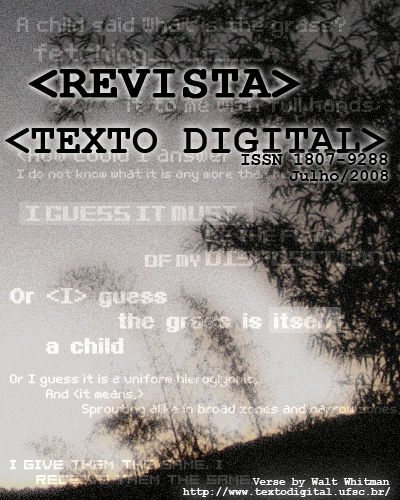

To the reader.
Não importa ao tempo o minuto que passa, mas o minuto que vem. O minuto que vem é forte, jocundo, supõe trazer em si a eternidade, e traz a morte, e perece como o outro, mas o tempo subsiste. Egoísmo, dizes tu? Sim, egoísmo, não tenho outra lei. Egoísmo, conservação. A onça mata o novilho porque o raciocínio da onça é que ela deve viver, e se o novilho é tenro tanto melhor: eis o estatuto universal. Sobe e olha.
Machado de Assis
Click. The brief space of this gesture can represent the difference between being and non-being in cyberspace.
Really?
Regarding time, we have chosen to cite Machado de Assis not only to leave his name marked in this publication on the one-hundredth year of his death, but because his work is a testimony that time does not always win.
In his delirium, Brás Cubas perceives the strength of the “minute that comes” and, at the same time, the fragility of his own existence. Time’s speed, it’s limits and the necessity that the oncoming substitutes the previous, expressed in the epigraph, refers us to the limitlessness of time-space in the internet and all the artistic (or supposedly artistic) that it encompasses.
Considering the ephemeral characteristic of the supposedly new turned old in the brief space of one click, brings forth the question: should we retain them? Substitute them incessantly? Or forget both? Construct or experiment: must we choose between them? Or seek a third alternative which encompasses both? These are a few questions that are brought forth by Edson Costa Duarte’s text. In “Babelization and Desbabelization (for a Utopy of Virtual)”, the author, mounting from the concept of time, presents and discusses other concepts, focusing his attention on the transitory characteristic of the virtual object.
By questioning the nature of this object we are lead to other questions that lay still unanswered: the production in digital medium requires a new conception of composition? Up to what point does the change in support change the nature of the artistic and/or literary object therein created? Those this change in support also effect the reading and interpretation of these objects? Up to what point those this new tool generate a new academic action, a new thought?
If there is one certainty in all this it is that this new support opens new fields of study. These are studies aided by the computer, generally interdisciplinary, requiring knowledge in the areas of informatics and statistics, and the knowledge of the analyzed text’s area. One of them utilizes textual statistics in means of investigating the authorship of texts based on their stylistic characteristics. It is in this field that lies the other article published in this edition.
José Carlos Jardim Júnior adventures himself in the investigation of a mystery which dates back to the eighteenth century: the authorship of the Cartas Chilenas. Utilizing textual stylistic resources, the article “Computer Analysis Annotations Regarding The Cartas Chilenas” studies stylistic aspects based on the group of Sapphic verse, adding to the existing studies regarding the Cartas more elements that contribute to the identification of their authorship.
The investigations that align the use of computers and methods of stylistic data analysis for the study of texts has almost half a century in countries like France, England and United States. In Brazil the field is still incipient with almost no bibliographic production and the foreign bibliography still occupying the shelves.
Initiated with the metering of the words from Saint Paul’s Epistles in the Bible done by Augusto de Morgan, the quantitative studies have their origin in 1851, according to Anthony Kenny and Susan Hockey. But the first publication in the area is attributed to another pioneer, the North-American T. C. Mendenhall who in 1887 tests the hypothesis that the extension of the words could be a distinctive characteristic in analyzing authorship, in his article “The characteristic curves of composition”.
This edition also brings three electronic artworks of Suzete Venturrelli, professor and researcher, member of the Instituto de Artes da Universidade de Brasília.
Welcome to the sixth edition of Texto Digital, an opened space to experimentation, creation and reflection on art and literature in the context of new technologies.
Deise Freitas
(translated by Otávio Guimarães)
CREATIONS
Curvas
Silepticoscorpos
Autômatos celulares bidimensionais
Suzete Venturelli
ESSAYS
BABELIZAÇÃO E DESBABELIZAÇÃO (PARA UMA UTOPIA DO VIRTUAL)
Edson Costa Duarte
APONTAMENTOS DE ANÁLISE INFORMATIZADA EM TORNO DAS CARTAS CHILENAS
José Carlos Jardim Junior
|
